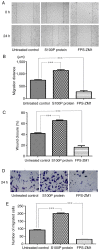Proof-of-concept study investigating the role of S100P-RAGE in nasopharyngeal carcinoma
- PMID: 33767765
- PMCID: PMC7976439
- DOI: 10.3892/etm.2021.9901
Proof-of-concept study investigating the role of S100P-RAGE in nasopharyngeal carcinoma
Abstract
Nasopharyngeal carcinoma (NPC) is an epithelial carcinoma that arises from the lining of the nasopharyngeal mucosa. The efficacy of radiation therapy is limited due to radiation resistance, particularly in the advanced stages of NPC. The S100P protein is a small isoform of the S100 protein family, which is involved in the regulation of various intracellular and extracellular processes, including proliferation, differentiation and intracellular signaling. The aim of the current study was to investigate the significance of the S100P-RAGE axis in NPC progression. The expression levels of S100P and receptor for activated glycation end-products (RAGE) in NPC specimens were determined by western blotting. In addition, the effect of the S100P-RAGE axis on NPC was evaluated in vitro by proliferation and migration assays using C666-1 cells treated with S100P or the RAGE inhibitor FPS-ZM1. The underlying mechanism was also investigated by western blotting. The expression of S100P and RAGE was detected in clinical specimens from 15 patients with NPC and 15 patients with benign nasopharyngeal inflammation, and was observed to be higher in NPC tissues compared with inflamed tissues. Furthermore, the interaction of S100P with RAGE increased the proliferation and migration potential of C666-1 cells, and activated mitogen-activated protein kinase and NF-κB signaling. These results indicate that the S100P-RAGE axis exerts a promoting effect on the progression of NPC. Therefore therapeutic strategies targeting S100P-RAGE merit further exploration for the treatment of NPC.
Keywords: C666-1 cells; RAGE; S100P; migration; proliferation.
Copyright: © Wang et al.
Conflict of interest statement
The authors declare that they have no competing interests.
Figures




Similar articles
-
S100P is associated with proliferation and migration in nasopharyngeal carcinoma.Oncol Lett. 2017 Jul;14(1):525-532. doi: 10.3892/ol.2017.6198. Epub 2017 May 17. Oncol Lett. 2017. PMID: 28693201 Free PMC article.
-
S100P stimulates cell proliferation and survival via receptor for activated glycation end products (RAGE).J Biol Chem. 2004 Feb 13;279(7):5059-65. doi: 10.1074/jbc.M310124200. Epub 2003 Nov 14. J Biol Chem. 2004. PMID: 14617629
-
RAGE activation by S100P in colon cancer stimulates growth, migration, and cell signaling pathways.Dis Colon Rectum. 2007 Aug;50(8):1230-40. doi: 10.1007/s10350-006-0850-5. Dis Colon Rectum. 2007. PMID: 17587138
-
S100P: a novel therapeutic target for cancer.Amino Acids. 2011 Oct;41(4):893-9. doi: 10.1007/s00726-010-0496-4. Epub 2010 May 28. Amino Acids. 2011. PMID: 20509035 Free PMC article. Review.
-
Transcriptional regulation and functional implication of S100P in cancer.Amino Acids. 2011 Oct;41(4):885-92. doi: 10.1007/s00726-010-0495-5. Epub 2010 Feb 14. Amino Acids. 2011. PMID: 20155429 Review.
Cited by
-
S100 proteins in head and neck squamous cell carcinoma (Review).Oncol Lett. 2023 Jul 6;26(2):362. doi: 10.3892/ol.2023.13948. eCollection 2023 Aug. Oncol Lett. 2023. PMID: 37545618 Free PMC article. Review.
-
Screening of core genes and prediction of ceRNA regulation mechanism of circRNAs in nasopharyngeal carcinoma by bioinformatics analysis.Pathol Oncol Res. 2023 Mar 28;29:1610960. doi: 10.3389/pore.2023.1610960. eCollection 2023. Pathol Oncol Res. 2023. PMID: 37056700 Free PMC article.
-
Insulin/IGF Axis and the Receptor for Advanced Glycation End Products: Role in Meta-inflammation and Potential in Cancer Therapy.Endocr Rev. 2023 Jul 11;44(4):693-723. doi: 10.1210/endrev/bnad005. Endocr Rev. 2023. PMID: 36869790 Free PMC article. Review.
-
S100A2 upregulates GLUT1 expression to promote glycolysis in the progression of nasopharyngeal carcinoma.Histol Histopathol. 2024 Dec;39(12):1669-1683. doi: 10.14670/HH-18-778. Epub 2024 Jun 11. Histol Histopathol. 2024. PMID: 38940398
References
LinkOut - more resources
Full Text Sources
Other Literature Sources
Miscellaneous
